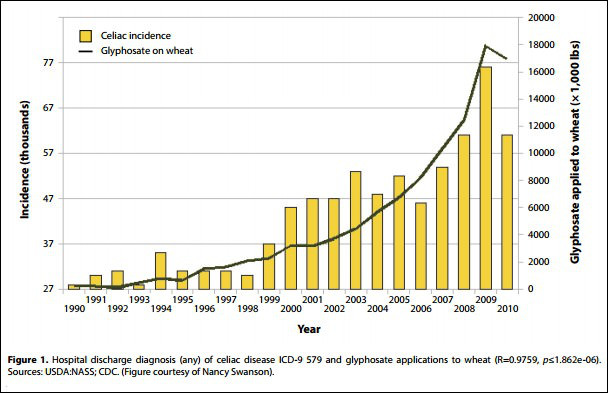GMOs Links
Do you or a loved one suffer from gluten sensitivity? You may be wondering why you react to gluten now even though you never did in the past. You may be wondering why a gluten-free diet has helped, but has not completely resolved your symptoms. If you are on a quest to find all of the pieces to the gluten puzzle, the following information is for you. In a report released today by the Institute for Responsible Technology, a team of experts proposes a possible link between genetically modified organisms (GMOs) and gluten-related disorders. The analysis is based on Dept. of Agriculture data, Environmental Protection Act records, medical journal reviews, and international research.

The full 24-page report, a press release, and a recorded interview can all be found at glutenandgmos.com. An article summarizing the findings of this report is presented below:
Can Genetically Engineered Foods Trigger Gluten Sensitivity?
Gluten sensitivity is currently estimated to affect as many as 18 million Americans. 1 Reactions to gluten, a protein found in wheat, rye, and barley, are becoming increasingly common. Gluten sensitivity can range in severity from mild discomfort, such as gas and bloating, to celiac disease, a serious autoimmune condition that can, if undiagnosed, result in a 4-fold increase in death. 2 Genetics alone cannot explain the rapid rise in gluten-related disorders, and experts believe that there must be an environmental trigger. There continues to be much debate about what that environmental trigger may be.
Some assert that a higher gluten content of modern wheat is to blame for the rising prevalence of gluten-related disorders. 3 But a 2013 review of data commissioned by the United States Department of Agriculture found no evidence to support this. 4 Others blame increased consumption of wheat overall, 4 age of wheat introduction, 5 cesarean birth, 6 breastfeeding duration, 7 or alterations in intestinal microflora. 8 All of these do offer some explanation, but they cannot completely account for the drastic increase in gluten sensitivities that we have seen in recent years.
Another possible environmental trigger may be the introduction of genetically modified organisms (GMOs) to the American food supply, which occurred in the mid-1990s. GMOs are created by a laboratory process that transfers genetic material into the DNA of an organism There are nine genetically modified (GM) food crops currently on the market: soy, corn, cotton (oil), canola (oil), sugar from sugar beets, zucchini, yellow squash, Hawaiian papaya, and alfalfa. Notice that wheat is not one of these. Although wheat has been hybridized through natural breeding techniques over the years, it is not in fact a GMO.
Most GM crops are engineered to tolerate a weed killer called Roundup®, whose active ingredient is glyphosate. These crops, known as Roundup-Ready crops, accumulate high levels of glyphosate that remain in the food. Corn and cotton varieties are also engineered to produce an insecticide called Bt-toxin. The Bt-toxin is produced in every cell of genetically engineered corn and ends up in corn chips, corn tortillas, and other ingredients derived from corn. A recent analysis of research suggests that Bt-toxin, glyphosate, and other components of GMOs, are linked to five conditions that may either initiate or exacerbate gluten-related disorders:
- Intestinal permeability
- Imbalanced gut bacteria
- Immune activation and allergies
- Impaired digestion
- Damage to the intestinal wall
Intestinal permeability
Gluten-related disorders are commonly accompanied by and possibly triggered by intestinal permeability, which is commonly referred to as “leaky gut.”9 Leaky gut occurs when gaps form between intestinal cells and large particles from the digestive tract enter the bloodstream, potentially triggering immune or allergic reactions. The Bt-toxin produced by genetically modified corn kills insects by punching holes in their digestive tracts, and a 2012 study confirmed that it punctures holes in human cells as well.10 Bt-toxin is present in every kernel of Bt corn, survives human digestion, and has been detected in the blood of 93% of pregnant women tested and 80% of their unborn fetuses.11 This “hole-punching toxin” may be a critical piece of the puzzle in understanding gluten-related disorders.
Imbalanced gut bacteria
Gluten-sensitive individuals, and especially those with celiac disease, also commonly have an imbalance in their gut flora.12,13,14,15 The reason that cesarean section increases risk 6 and breastfeeding decreases risk 7 for gluten sensitivity is likely due to their respective effects on microbial balance in the infant’s gut. 16 Glyphosate used on GM crops is not only an herbicide, but also a potent antibiotic. Even with minimal exposure, glyphosate can significantly reduce the population of beneficial gut bacteria and promote the overgrowth of harmful strains.17 18 An overgrowth of harmful bacteria can promote inflammation, leaky gut, and immune reactions, all of which are linked to gluten-related disorders.
Immune activation and allergies
Many people do not develop reactivity to gluten until later in life, which supports the notion that it can be triggered by environmental factors. The only study to date that has been able to effectively trigger an immunological shift to gluten sensitivity was done in mice in 2011. 19 The study showed that retinoic acid, a metabolite of vitamin A, activated a specific immune response to gluten under inflammatory conditions in the gut. It turns out that glyphosate, the primary herbicide used on GM crops, increases retinoic acid activity. 20 If glyphosate activates retinoic acid, and retinoic acid activates gluten sensitivity, eating GMOs soaked with glyphosate may play a role in the onset of glute-related disorders.
Bt-toxin may also activate the immune system. When mice were exposed to Bt-toxin, they not only mounted an immune response to it directly, but they subsequently reacted to foods that had not formerly triggered a response.21 There was something about the Bt-toxin that primed the immune system to become reactive to other, once benign, foods. If humans exposed to Bt-toxin react in a similar manner, eating GM corn could directly lead to the development of gluten or other food sensitivities.
Impaired digestion
Decreased digestive enzymes can create undigested food particles, contribute to the overgrowth of harmful bacteria, and promote symptoms of gluten-related disorders. Studies of mice eating Roundup Ready soy and fish exposed to glyphosate show that these compounds reduce digestive enzymes. 22 23 All soybeans contain trypsin inhibitor, which blocks an important enzyme needed to digest protein, but Roundup Ready® soybeans contain as much as seven times more than non-GMO soy.24,25 The results of these studies suggest that genetically engineered foods may lead to serious digestive compromise.
Damage to the intestinal wall
A common result of gluten sensitivity is damage to the lining of the intestinal tract. Celiac disease results in flattening of the microvilli lining the walls of the intestine. Both Bt-toxin and glyphosate have produced structural damage to microvilli in animal studies; animals exposed to these substances developed microvilli that were broken off, discontinuous, or shortened. 26 23

Stay Away from GMOs
A clear explanation for the rising rate of gluten-related disorders remains elusive. Multiple factors interact, with no clear or original cause. But genetically modified foods and their primary chemical residue, glyphosate, may be an important piece of the puzzle. Whether GMOs are indeed a causative factor in the escalating trend of gluten sensitivity or merely an obstacle to cure is yet to be determined.
Many clinicians already prescribe non-GMO diets for their gluten-sensitive patients. Physicians and patients have reported improvement in their symptoms after eliminating GMOs from their diets. Internist, Emily Linder MD, says, “Based on my clinical experience, when I remove genetically modified foods as part of the treatment for gluten sensitivity, recovery is faster and more complete. I believe that GMOs in our diet contribute to the rise in gluten sensitivity in the U.S. population.”
Unfortunately, many people who discover they are gluten-sensitive actually increase their intake of GMOs because they switch from wheat products to corn products. With 88% of the U.S. corn crop genetically engineered, avoidance of GMOs in the gluten-free community presents a unique challenge to consumers.
The best way to avoid GMOs is to consult the NonGMOShoppingGuide.com or download the free iPhone app ShopNoGMO. Look for products with either the “Non-GMO Project Verified” or the “Certified Organic” seal. Avoid ingredients derived from the foods most likely to be genetically modified. These include soy, corn, cottonseed, canola, sugar, papaya from Hawaii or China, zucchini, and yellow squash.
If you have seen improvement in a gluten-related condition after eliminating GMOs from your diet, please email healthy@responsibletechnology.org to share your story.
Do you or a loved one suffer from gluten sensitivity? You may be wondering why you react to gluten now even though you never did in the past. You may be wondering why a gluten-free diet has helped, but has not completely resolved your symptoms. If you are on a quest to find all of the pieces to the gluten puzzle, the following information is for you. In a report released today by the Institute for Responsible Technology, a team of experts proposes a possible link between genetically modified organisms (GMOs) and gluten-related disorders. The analysis is based on Dept. of Agriculture data, Environmental Protection Act records, medical journal reviews, and international research.
The full 24-page report, a press release, and a recorded interview can all be found at glutenandgmos.com. An article summarizing the findings of this report is presented below:
Can Genetically Engineered Foods Trigger Gluten Sensitivity?
Gluten sensitivity is currently estimated to affect as many as 18 million Americans. 1 Reactions to gluten, a protein found in wheat, rye, and barley, are becoming increasingly common. Gluten sensitivity can range in severity from mild discomfort, such as gas and bloating, to celiac disease, a serious autoimmune condition that can, if undiagnosed, result in a 4-fold increase in death. 2 Genetics alone cannot explain the rapid rise in gluten-related disorders, and experts believe that there must be an environmental trigger. There continues to be much debate about what that environmental trigger may be.
Some assert that a higher gluten content of modern wheat is to blame for the rising prevalence of gluten-related disorders. 3 But a 2013 review of data commissioned by the United States Department of Agriculture found no evidence to support this. 4 Others blame increased consumption of wheat overall, 4 age of wheat introduction, 5 cesarean birth, 6 breastfeeding duration, 7 or alterations in intestinal microflora. 8 All of these do offer some explanation, but they cannot completely account for the drastic increase in gluten sensitivities that we have seen in recent years.
Another possible environmental trigger may be the introduction of genetically modified organisms (GMOs) to the American food supply, which occurred in the mid-1990s. GMOs are created by a laboratory process that transfers genetic material into the DNA of an organism There are nine genetically modified (GM) food crops currently on the market: soy, corn, cotton (oil), canola (oil), sugar from sugar beets, zucchini, yellow squash, Hawaiian papaya, and alfalfa. Notice that wheat is not one of these. Although wheat has been hybridized through natural breeding techniques over the years, it is not in fact a GMO.
Most GM crops are engineered to tolerate a weed killer called Roundup®, whose active ingredient is glyphosate. These crops, known as Roundup-Ready crops, accumulate high levels of glyphosate that remain in the food. Corn and cotton varieties are also engineered to produce an insecticide called Bt-toxin. The Bt-toxin is produced in every cell of genetically engineered corn and ends up in corn chips, corn tortillas, and other ingredients derived from corn. A recent analysis of research suggests that Bt-toxin, glyphosate, and other components of GMOs, are linked to five conditions that may either initiate or exacerbate gluten-related disorders:
- Intestinal permeability
- Imbalanced gut bacteria
- Immune activation and allergies
- Impaired digestion
- Damage to the intestinal wall
Intestinal permeability
Gluten-related disorders are commonly accompanied by and possibly triggered by intestinal permeability, which is commonly referred to as “leaky gut.”9 Leaky gut occurs when gaps form between intestinal cells and large particles from the digestive tract enter the bloodstream, potentially triggering immune or allergic reactions. The Bt-toxin produced by genetically modified corn kills insects by punching holes in their digestive tracts, and a 2012 study confirmed that it punctures holes in human cells as well.10 Bt-toxin is present in every kernel of Bt corn, survives human digestion, and has been detected in the blood of 93% of pregnant women tested and 80% of their unborn fetuses.11 This “hole-punching toxin” may be a critical piece of the puzzle in understanding gluten-related disorders.
Imbalanced gut bacteria
Gluten-sensitive individuals, and especially those with celiac disease, also commonly have an imbalance in their gut flora.12,13,14,15 The reason that cesarean section increases risk 6 and breastfeeding decreases risk 7 for gluten sensitivity is likely due to their respective effects on microbial balance in the infant’s gut. 16 Glyphosate used on GM crops is not only an herbicide, but also a potent antibiotic. Even with minimal exposure, glyphosate can significantly reduce the population of beneficial gut bacteria and promote the overgrowth of harmful strains.1718 An overgrowth of harmful bacteria can promote inflammation, leaky gut, and immune reactions, all of which are linked to gluten-related disorders.
Immune activation and allergies
Many people do not develop reactivity to gluten until later in life, which supports the notion that it can be triggered by environmental factors. The only study to date that has been able to effectively trigger an immunological shift to gluten sensitivity was done in mice in 2011. 19 The study showed that retinoic acid, a metabolite of vitamin A, activated a specific immune response to gluten under inflammatory conditions in the gut. It turns out that glyphosate, the primary herbicide used on GM crops, increases retinoic acid activity. 20If glyphosate activates retinoic acid, and retinoic acid activates gluten sensitivity, eating GMOs soaked with glyphosate may play a role in the onset of glute-related disorders.
Bt-toxin may also activate the immune system. When mice were exposed to Bt-toxin, they not only mounted an immune response to it directly, but they subsequently reacted to foods that had not formerly triggered a response.21There was something about the Bt-toxin that primed the immune system to become reactive to other, once benign, foods. If humans exposed to Bt-toxin react in a similar manner, eating GM corn could directly lead to the development of gluten or other food sensitivities.
Impaired digestion
Decreased digestive enzymes can create undigested food particles, contribute to the overgrowth of harmful bacteria, and promote symptoms of gluten-related disorders. Studies of mice eating Roundup Ready soy and fish exposed to glyphosate show that these compounds reduce digestive enzymes. 2223 All soybeans contain trypsin inhibitor, which blocks an important enzyme needed to digest protein, but Roundup Ready® soybeans contain as much as seven times more than non-GMO soy.24,25 The results of these studies suggest that genetically engineered foods may lead to serious digestive compromise.
Damage to the intestinal wall
A common result of gluten sensitivity is damage to the lining of the intestinal tract. Celiac disease results in flattening of the microvilli lining the walls of the intestine. Both Bt-toxin and glyphosate have produced structural damage to microvilli in animal studies; animals exposed to these substances developed microvilli that were broken off, discontinuous, or shortened. 2623
Stay Away from GMOs
A clear explanation for the rising rate of gluten-related disorders remains elusive. Multiple factors interact, with no clear or original cause. But genetically modified foods and their primary chemical residue, glyphosate, may be an important piece of the puzzle. Whether GMOs are indeed a causative factor in the escalating trend of gluten sensitivity or merely an obstacle to cure is yet to be determined.
Many clinicians already prescribe non-GMO diets for their gluten-sensitive patients. Physicians and patients have reported improvement in their symptoms after eliminating GMOs from their diets. Internist, Emily Linder MD, says, “Based on my clinical experience, when I remove genetically modified foods as part of the treatment for gluten sensitivity, recovery is faster and more complete. I believe that GMOs in our diet contribute to the rise in gluten sensitivity in the U.S. population.”
Unfortunately, many people who discover they are gluten-sensitive actually increase their intake of GMOs because they switch from wheat products to corn products. With 88% of the U.S. corn crop genetically engineered, avoidance of GMOs in the gluten-free community presents a unique challenge to consumers.
The best way to avoid GMOs is to consult the NonGMOShoppingGuide.com or download the free iPhone app ShopNoGMO. Look for products with either the “Non-GMO Project Verified” or the “Certified Organic” seal. Avoid ingredients derived from the foods most likely to be genetically modified. These include soy, corn, cottonseed, canola, sugar, papaya from Hawaii or China, zucchini, and yellow squash.
If you have seen improvement in a gluten-related condition after eliminating GMOs from your diet, please email healthy@responsibletechnology.org to share your story.
References
1. Center for Celiac Research and Treatment. Accessed on November 20, 2013 at http://celiacdisease.about.com/od/glutenintolerance/a/How-Many-People-Have-Gluten-Sensitivity.htm
2. Rubio-Tapia A, Kyle RA, Kaplan EL et al. Increased prevalence and mortality in undiagnosed celiac disease. Gastroenterology. 2009;137 (1):88-93.
3. Sapone A, Bai JC, Ciacci C et al. Spectrum of gluten-related disorders: consensus on new nomenclature and classification. BMC Med. 2012;10 13.
4. Kasarda DD. Can an increase in celiac disease be attributed to an increase in the gluten content of wheat as a consequence of wheat breeding? J Agric Food Chem. 2013;61 (6):1155-1159.
5. Sellitto M, Bai G, Serena G et al. Proof of concept of microbiome-metabolome analysis and delayed gluten exposure on celiac disease autoimmunity in genetically at-risk infants. PLoS One. 2012;7 (3):e33387.
6. Decker E, Hornef M, Stockinger S. Cesarean delivery is associated with celiac disease but not inflammatory bowel disease in children. Gut Microbes. 2011;2 (2):91-98.
7. Henriksson C, Bostrom AM, Wiklund IE. What effect does breastfeeding have on coeliac disease? A systematic review update. Evid Based Med. 2013;18 (3):98-103.
8. Cinova J, De Palma G, Stepankova R et al. Role of intestinal bacteria in gliadin-induced changes in intestinal mucosa: study in germ-free rats. PLoS One. 2011;6 (1):e16169.
9. Arranz E, Bode J, Kingstone K, Ferguson A. Intestinal antibody pattern of coeliac disease: association with gamma/delta T cell receptor expression by intraepithelial lymphocytes, and other indices of potential coeliac disease. Gut. 1994;35 (4):476-482.
10. Mesnage R, Clair E, Gress S, Then C, Szekacs A, Seralini GE. Cytotoxicity on human cells of Cry1Ab and Cry1Ac Bt insecticidal toxins alone or with a glyphosate-based herbicide. J Appl Toxicol. 2013;33 (7):695-699.
11. Aris A, Leblanc S. Maternal and fetal exposure to pesticides associated to genetically modified foods in Eastern Townships of Quebec, Canada. Reprod Toxicol. 2011;31 (4):528-533.
12. Collado MC, Donat E, Ribes-Koninckx C, Calabuig M, Sanz Y. Specific duodenal and faecal bacterial groups associated with paediatric coeliac disease. J Clin Pathol. 2009;62 (3):264-269.
13. Tursi A, Brandimarte G, Giorgetti G. High prevalence of small intestinal bacterial overgrowth in celiac patients with persistence of gastrointestinal symptoms after gluten withdrawal. Am J Gastroenterol. 2003;98 (4):839-843.
14. Sanchez E, Nadal I, Donat E, Ribes-Koninckx C, Calabuig M, Sanz Y. Reduced diversity and increased virulence-gene carriage in intestinal enterobacteria of coeliac children. BMC Gastroenterol. 2008;8 50.
15. Nadal I, Donat E, Ribes-Koninckx C, Calabuig M, Sanz Y. Imbalance in the composition of the duodenal microbiota of children with coeliac disease. J Med Microbiol. 2007;56 (Pt 12):1669-1674.
16. Palma GD, Capilla A, Nova E et al. Influence of milk-feeding type and genetic risk of developing coeliac disease on intestinal microbiota of infants: the PROFICEL study. PLoS One. 2012;7 (2):e30791.
17. Shehata AA, Schrodl W, Aldin AA, Hafez HM, Kruger M. The effect of glyphosate on potential pathogens and beneficial members of poultry microbiota in vitro. Curr Microbiol. 2013;66 (4):350-358.
18. Kruger M, Shehata AA, Schrodl W, Rodloff A. Glyphosate suppresses the antagonistic effect of Enterococcus spp. on Clostridium botulinum. Anaerobe. 2013;20 74-78.
19. DePaolo RW, Abadie V, Tang F et al. Co-adjuvant effects of retinoic acid and IL-15 induce inflammatory immunity to dietary antigens. Nature. 2011;471 (7337):220-224.
20. Paganelli A, Gnazzo V, Acosta H, Lopez SL, Carrasco AE. Glyphosate-based herbicides produce teratogenic effects on vertebrates by impairing retinoic acid signaling. Chem Res Toxicol. 2010;23 (10):1586-1595.
21. Finamore A, Roselli M, Britti S et al. Intestinal and peripheral immune response to MON810 maize ingestion in weaning and old mice. J Agric Food Chem. 2008;56 (23):11533-11539.
22. Malatesta M, Caporaloni C, Rossi L et al. Ultrastructural analysis of pancreatic acinar cells from mice fed on genetically modified soybean. J Anat. 2002;201 (5):409-415.
23. Senapati T, Mukerjee A, Ghosh A et al. Observations on the effect of glyphosate based herbicide on ultra structure (SEM) and enzymatic activity in different regions of alimentary canal and gill of Channa punctatus. Journal of Crop and Weed. 2009;5 (1):236-245.
24. Padgette SR, Taylor NB, Nida DL et al. The composition of glyphosate-tolerant soybean seeds is equivalent to that of conventional soybeans. J Nutr. 1996;126 (3):702-716.
25. Pusztai A, Bardocz S. GMO in animal nutrition; potential benefits and risks. Biology of Nutrition in Growing Animals. Elsevier; 2005
26. Fares NH, El-Sayed AK. Fine structural changes in the ileum of mice fed on delta-endotoxin-treated potatoes and transgenic potatoes. Nat Toxins. 1998;6 (6):219-233.
Source: News Release: GMOs Linked to Exploding Gluten Sensitivity Epidemic
References
1. Center for Celiac Research and Treatment. Accessed on November 20, 2013 at http://celiacdisease.about.com/od/glutenintolerance/a/How-Many-People-Have-Gluten-Sensitivity.htm
2. Rubio-Tapia A, Kyle RA, Kaplan EL et al. Increased prevalence and mortality in undiagnosed celiac disease. Gastroenterology. 2009;137 (1):88-93.
3. Sapone A, Bai JC, Ciacci C et al. Spectrum of gluten-related disorders: consensus on new nomenclature and classification. BMC Med. 2012;10 13.
4. Kasarda DD. Can an increase in celiac disease be attributed to an increase in the gluten content of wheat as a consequence of wheat breeding? J Agric Food Chem. 2013;61 (6):1155-1159.
5. Sellitto M, Bai G, Serena G et al. Proof of concept of microbiome-metabolome analysis and delayed gluten exposure on celiac disease autoimmunity in genetically at-risk infants. PLoS One. 2012;7 (3):e33387.
6. Decker E, Hornef M, Stockinger S. Cesarean delivery is associated with celiac disease but not inflammatory bowel disease in children. Gut Microbes. 2011;2 (2):91-98.
7. Henriksson C, Bostrom AM, Wiklund IE. What effect does breastfeeding have on coeliac disease? A systematic review update. Evid Based Med. 2013;18 (3):98-103.
8. Cinova J, De Palma G, Stepankova R et al. Role of intestinal bacteria in gliadin-induced changes in intestinal mucosa: study in germ-free rats. PLoS One. 2011;6 (1):e16169.
9. Arranz E, Bode J, Kingstone K, Ferguson A. Intestinal antibody pattern of coeliac disease: association with gamma/delta T cell receptor expression by intraepithelial lymphocytes, and other indices of potential coeliac disease. Gut. 1994;35 (4):476-482.
10. Mesnage R, Clair E, Gress S, Then C, Szekacs A, Seralini GE. Cytotoxicity on human cells of Cry1Ab and Cry1Ac Bt insecticidal toxins alone or with a glyphosate-based herbicide. J Appl Toxicol. 2013;33 (7):695-699.
11. Aris A, Leblanc S. Maternal and fetal exposure to pesticides associated to genetically modified foods in Eastern Townships of Quebec, Canada. Reprod Toxicol. 2011;31 (4):528-533.
12. Collado MC, Donat E, Ribes-Koninckx C, Calabuig M, Sanz Y. Specific duodenal and faecal bacterial groups associated with paediatric coeliac disease. J Clin Pathol. 2009;62 (3):264-269.
13. Tursi A, Brandimarte G, Giorgetti G. High prevalence of small intestinal bacterial overgrowth in celiac patients with persistence of gastrointestinal symptoms after gluten withdrawal. Am J Gastroenterol. 2003;98 (4):839-843.
14. Sanchez E, Nadal I, Donat E, Ribes-Koninckx C, Calabuig M, Sanz Y. Reduced diversity and increased virulence-gene carriage in intestinal enterobacteria of coeliac children. BMC Gastroenterol. 2008;8 50.
15. Nadal I, Donat E, Ribes-Koninckx C, Calabuig M, Sanz Y. Imbalance in the composition of the duodenal microbiota of children with coeliac disease. J Med Microbiol. 2007;56 (Pt 12):1669-1674.
16. Palma GD, Capilla A, Nova E et al. Influence of milk-feeding type and genetic risk of developing coeliac disease on intestinal microbiota of infants: the PROFICEL study. PLoS One. 2012;7 (2):e30791.
17. Shehata AA, Schrodl W, Aldin AA, Hafez HM, Kruger M. The effect of glyphosate on potential pathogens and beneficial members of poultry microbiota in vitro. Curr Microbiol. 2013;66 (4):350-358.
18. Kruger M, Shehata AA, Schrodl W, Rodloff A. Glyphosate suppresses the antagonistic effect of Enterococcus spp. on Clostridium botulinum. Anaerobe. 2013;20 74-78.
19. DePaolo RW, Abadie V, Tang F et al. Co-adjuvant effects of retinoic acid and IL-15 induce inflammatory immunity to dietary antigens. Nature. 2011;471 (7337):220-224.
20. Paganelli A, Gnazzo V, Acosta H, Lopez SL, Carrasco AE. Glyphosate-based herbicides produce teratogenic effects on vertebrates by impairing retinoic acid signaling. Chem Res Toxicol. 2010;23 (10):1586-1595.
21. Finamore A, Roselli M, Britti S et al. Intestinal and peripheral immune response to MON810 maize ingestion in weaning and old mice. J Agric Food Chem. 2008;56 (23):11533-11539.
22. Malatesta M, Caporaloni C, Rossi L et al. Ultrastructural analysis of pancreatic acinar cells from mice fed on genetically modified soybean. J Anat. 2002;201 (5):409-415.
23. Senapati T, Mukerjee A, Ghosh A et al. Observations on the effect of glyphosate based herbicide on ultra structure (SEM) and enzymatic activity in different regions of alimentary canal and gill of Channa punctatus. Journal of Crop and Weed. 2009;5 (1):236-245.
24. Padgette SR, Taylor NB, Nida DL et al. The composition of glyphosate-tolerant soybean seeds is equivalent to that of conventional soybeans. J Nutr. 1996;126 (3):702-716.
25. Pusztai A, Bardocz S. GMO in animal nutrition; potential benefits and risks. Biology of Nutrition in Growing Animals. Elsevier; 2005
26. Fares NH, El-Sayed AK. Fine structural changes in the ileum of mice fed on delta-endotoxin-treated potatoes and transgenic potatoes. Nat Toxins. 1998;6 (6):219-233.
Source: News Release: GMOs Linked to Exploding Gluten Sensitivity Epidemic




